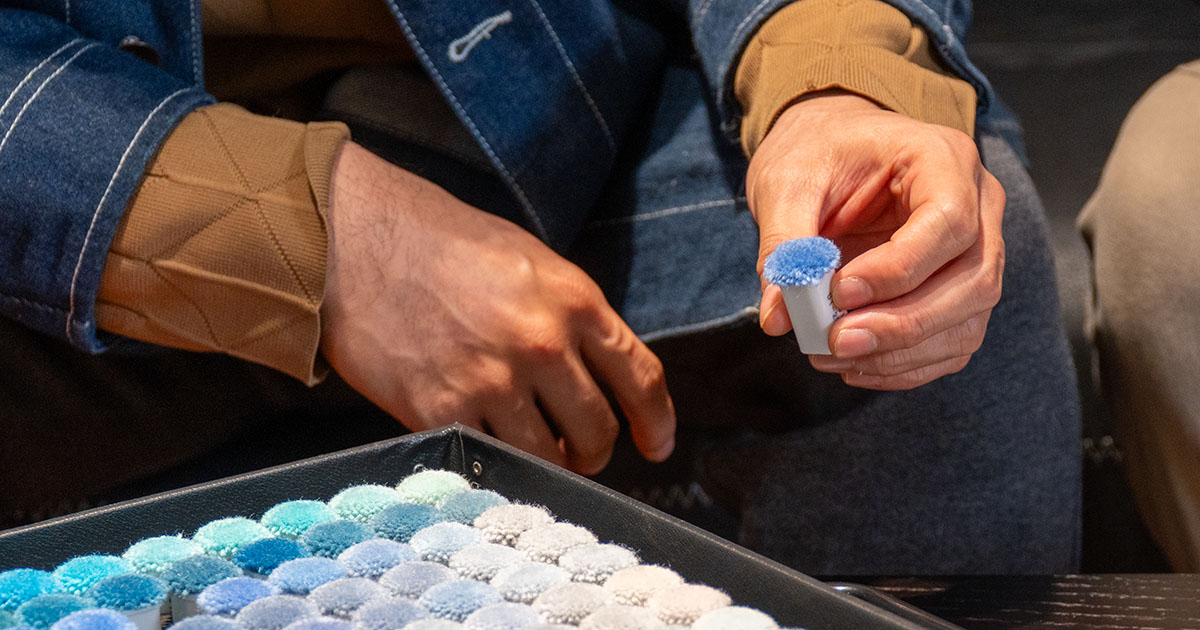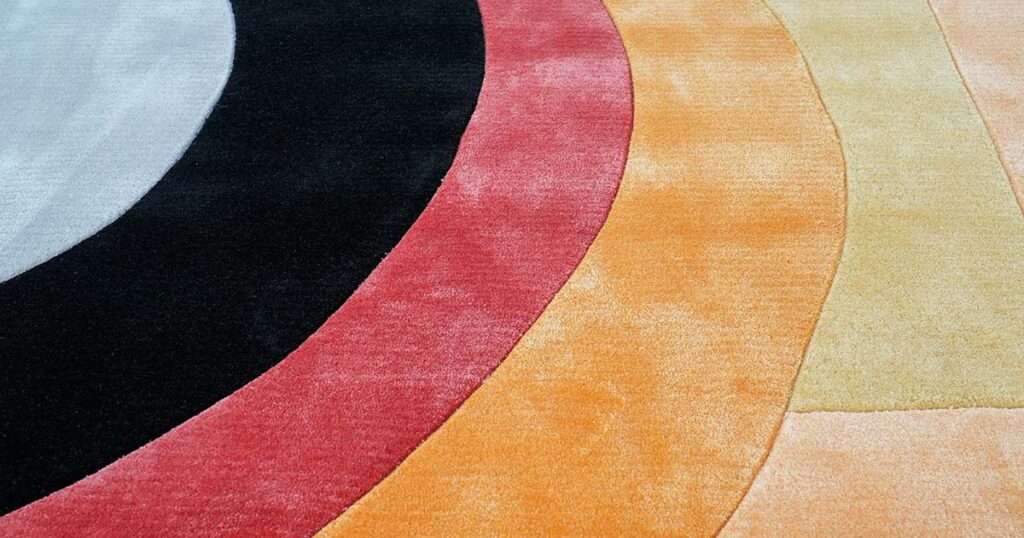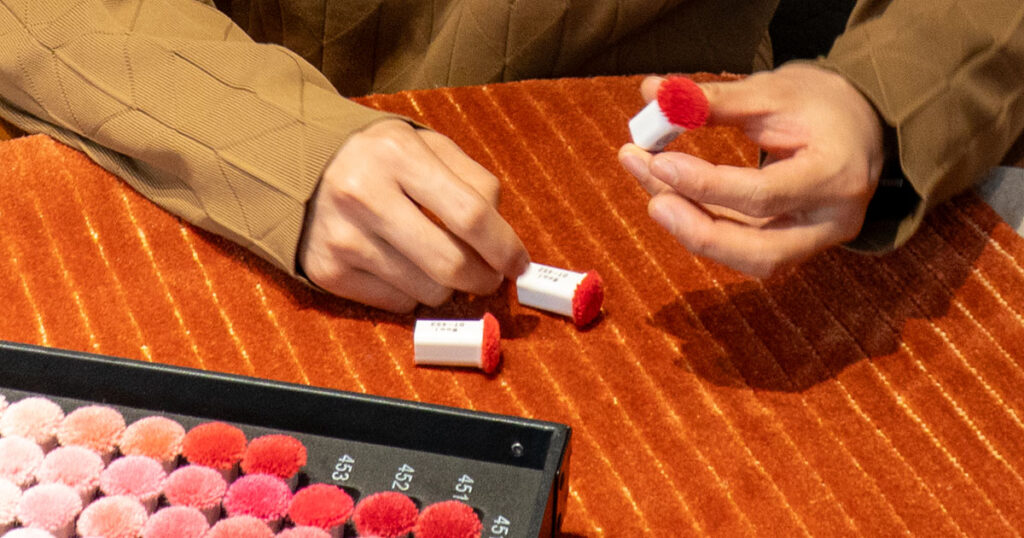Designing a custom tufted rug can transform your space and showcase your personal style.
Whether you’re looking to enhance your home or create a statement piece for a commercial space, understanding the nuances of rug design will help you create something both beautiful and functional that stands the test of time.
Why Custom Tufted Rugs?
Tufted rugs offer remarkable flexibility in design and are created by pushing yarn through a backing material to form the pile (the surface fibers). They come in two main varieties: hand-tufted and machine-tufted.
Hand-tufted rugs are created using a handheld tufting gun by skilled artisans who follow a pattern drawn on stretched backing cloth.
- This method allows for incredible artistic freedom and detail.
Machine-tufted rugs use mechanized equipment with hundreds of needles simultaneously punching through backing material.
- This method produces consistent results at greater scale and often lower cost.
The benefits of custom tufted rugs extend beyond mere aesthetics. They allow for precise color matching to existing décor, can be sized exactly to your space, and offer a perfect vehicle for personal expression.
For commercial spaces, they provide opportunities for branded elements while maintaining specific performance requirements.
Unlike mass-produced rugs, a custom piece can perfectly balance your needs for both beauty and function.
Gather Inspiration & Define Your Concept
Before jumping into specific designs, take time to collect ideas and define what you want to achieve. Consider your interior style—whether modern, traditional, or eclectic—and gather images that resonate with your vision. Look at existing elements in your space that might inspire color choices or patterns.
Create a concept statement that captures your vision.
- For example: “A hand-tufted wool rug for my living room inspired by autumn forest colors, featuring abstract leaf motifs in warm amber, burgundy, and deep green tones to create a cozy, nature-inspired atmosphere that complements my leather furniture.”
This initial concept stage shouldn’t be rushed. Often the most successful custom rugs emerge from a well-defined vision rather than jumping straight to pattern selection.
Consider how the rug will make you feel when you enter the room, and what role it should play in your overall design—whether as a subtle supporting element or a dramatic centerpiece.
Determine Size, Shape, & Layout
The right dimensions are crucial for a balanced look and proper function. For living rooms, your furniture should either sit completely on the rug or have front legs on it, with at least 18-24 inches of rug extending beyond the seating area. In dining areas, ensure the rug extends at least 24″ beyond the table edge so chairs remain on the rug when pulled out.
When considering shape, think beyond just rectangles. Circular rugs can soften a room with too many angular elements, while organic shapes can create visual interest in minimalist spaces. For open floor plans, consider how a rug might help define different functional zones.
Use painter’s tape to mark dimensions on your floor and live with it for a few days before committing. This simple step can prevent costly sizing mistakes and help you visualize how the rug will interact with furniture and traffic patterns.
For hallways and high-traffic areas, consider extending the length to minimize visible wear paths at entry and exit points. Remember that in commercial settings, rug size might need to accommodate ADA requirements, so consult guidelines if applicable.
Develop the Pattern and Scale
This is where your rug comes to life through creative decisions about design elements and their relative size. Pattern scale dramatically affects both visual impact and practical performance.
Large-scale patterns create dramatic focal points and work well in spacious areas with high ceilings. A single oversized motif or widely-spaced elements can make a strong statement. However, large patterns might get partially hidden under furniture, so consider furniture placement when designing. In commercial settings, large patterns often work well in lobbies or reception areas where they can be fully appreciated.
Small-scale patterns add texture and can make a space feel cozier, while also hiding dirt and wear better than large, uninterrupted designs. Tightly repeating patterns or small motifs distributed across the rug create visual texture that’s forgiving of spills and high traffic. These work particularly well in dining areas, family rooms, and busy commercial spaces.
Consider the viewing angle as well. Patterns will be seen both from standing height and from above when seated. Some designs that look striking in a rendering might lose impact when viewed in real space, so try to visualize from multiple angles.
For sophisticated spaces, consider tone-on-tone patterns where the design emerges through texture variation rather than color contrast. This approach creates subtle elegance while maintaining visual cohesion—for example, a floral pattern executed entirely in different pile heights of the same navy blue wool.
Choose Your Color Palette
Colors not only define the aesthetic impact of your rug but also its practicality in daily use. Start by considering your existing space elements—furniture, wall color, artwork—then determine whether you want the rug to harmonize or provide contrast.
When selecting colors, natural light exposure in the room matters significantly. Northern-facing rooms receive cooler light that can make cool colors appear more intense and warm colors more muted. Southern exposure has the opposite effect, enhancing warm tones while potentially washing out cooler hues. Always try to view color samples in the actual space where the rug will live.
For homes with children and pets, consider how color choices affect maintenance. Medium tones in the greige (gray-beige) family show less dirt than very light or dark colors. Variegated colors and patterns with multiple hues will hide stains and soil much better than solid colors. Consider placing darker or more heavily patterned sections at the rug’s edges where dirt accumulates first.
Color psychology also plays a role in how the rug affects mood. Blues and greens promote calmness and work well in bedrooms or contemplative spaces. Reds and oranges stimulate conversation and appetite, making them suitable for dining and social areas. Neutrals provide versatility but might need texture or subtle pattern variation to prevent a flat appearance.
For commercial spaces, consider brand colors but don’t feel obligated to use them at full saturation. Often, incorporating brand hues as accents within a more neutral scheme creates a sophisticated reference to brand identity without overwhelming the space.
Select Texture, Pile Height, and Finish
Texture creates dimension and tactile interest while significantly affecting performance. The interplay between pile height and construction technique determines how your rug feels underfoot and how it wears over time.
Pile height options typically range from low (1/4 inch or 6mm) to high (1/2 inch or 12mm+). Low pile offers a flatter profile with sharper pattern definition and easier maintenance. High pile creates a luxurious, soft feel but shows footprints and requires more vigorous vacuuming to remove debris that sinks between fibers.
The choice between cut pile and loop pile dramatically affects both appearance and durability. Cut pile, where the yarn loops are sheared at the top, creates a plush, velvet-like surface that’s soft underfoot but can show traffic patterns over time. Loop pile, where the yarn forms uncut loops, offers exceptional durability as each strand remains anchored at both ends, resisting crushing and matting. This makes loop pile an excellent choice for hallways, entryways, and other high-traffic zones.
Many sophisticated custom rugs utilize a combination approach, with loop pile in high-traffic areas and cut pile in low-traffic sections. This technique can also create textural patterns without color changes—for instance, a geometric design where the pattern is cut pile against a loop pile background, all in the same color.
Density matters as much as height—a dense, tightly-packed low pile rug often performs better and feels more luxurious than a loosely-tufted high pile one. For commercial settings, ask about density ratings (like HT-450, HT-550, or HT-650 for hand-tufted rugs), with higher numbers indicating greater durability.
For added dimension, consider carved details where the pile around pattern elements is trimmed slightly lower, creating definition through shadow lines rather than just color contrast. This sophisticated technique adds visual depth and can make even single-color rugs appear more intricate.
Choose Materials Wisely
Your material choice fundamentally determines how your rug looks, feels, performs, and ages over time. Understanding the properties of different fibers helps balance aesthetics, durability, and budget.
Wool represents the premium choice for tufted rugs, particularly New Zealand wool known for its softness and luster. Its natural resilience comes from fiber structure—each strand contains microscopic “scales” and a natural crimp that allows it to bounce back from compression. Wool naturally repels liquids and soil due to its lanolin content, giving you crucial seconds to blot spills before they penetrate. It’s also naturally flame-retardant, absorbs sound, and improves indoor air quality by capturing and holding airborne particles until vacuuming.
The downsides of wool include higher cost, some initial shedding (which diminishes over time), and potential moth attraction if left undisturbed in storage. Despite these minor drawbacks, wool remains the gold standard for longevity—a high-quality wool rug can last decades with proper care, often developing a beautiful patina rather than looking worn.
Nylon offers excellent durability at a lower price point, making it the workhorse of commercial carpet installations. When solution-dyed (color added during fiber creation rather than surface dyeing), nylon resists fading from sunlight and harsh cleaning. It can be engineered for specific performance characteristics—stain resistance, static control, or particular textures. While not as naturally resilient as wool, good quality nylon bounces back well from furniture indentations and foot traffic.
The limitations of nylon include less warmth underfoot, potential static issues in very dry environments, and a shorter overall lifespan than wool. It’s also petroleum-based, which raises sustainability concerns for some consumers.
For the best of both worlds, consider wool-nylon blends (typically 80% wool/20% nylon), which combine wool’s natural benefits with nylon’s strength and stain resistance. These blends perform exceptionally well in busy households and high-traffic commercial areas while maintaining a luxurious feel.
Other materials include polypropylene (highly stain-resistant but prone to crushing), polyester (soft with vibrant colors but less durable), and specialty fibers like bamboo silk (viscose) that add lustrous accents but should be used sparingly due to their delicacy.
Working with Manufacturers
Communicating Your Design
Clear communication prevents costly mistakes and disappointment. Create a comprehensive design document that includes artwork of your rug design, precise color specifications, material requirements, construction details, and any special finishing notes.
For color specification, don’t rely solely on digital color values, which can vary dramatically between screens. Use standardized references like Pantone codes (TPX system for textiles) or physical color swatches. Some manufacturers maintain yarn “pom” libraries with numbered color samples—if available, specify colors using their system for greatest accuracy.
Provide detailed information about pile height variations and texture transitions. For example, “Background in 10mm cut pile; border pattern in 8mm loop pile; carve 1mm depth around leaf motifs for definition.” Be specific about edge treatments too—whether you want binding, serging, fringe, or another finishing technique.
For designs incorporating logos or text, supply vector files if possible, ensuring clean edges without pixelation. Discuss minimum size limitations with your manufacturer—text smaller than about 1/4 inch (6mm) in width might not reproduce clearly in tufted construction.
Maintenance Considerations and Longevity
Designing for longevity requires thinking beyond initial appearance to how the rug will perform over years of use.
Traffic patterns dramatically affect wear. In residential settings, the areas in front of sofas, entryways, and hallways receive the heaviest use. In commercial spaces, main pathways and areas near entries see intense daily traffic. Design with these patterns in mind—perhaps using more durable loop pile in high-traffic zones while reserving luxurious high pile for less-traveled areas.
Maintenance requirements should influence material and color choices. Wool naturally releases soil during cleaning and hides dirt between vacuuming sessions. Solution-dyed nylon resists harsh cleaning agents, making it suitable for environments where frequent deep cleaning might be necessary. For dining areas or spaces where spills are likely, avoid highly absorbent materials like viscose or silk, which can permanently stain.
Proper backing construction significantly impacts durability. A quality hand-tufted rug should have sufficient latex adhesive to secure tufts firmly without making the rug overly stiff. Machine-tufted commercial carpets often feature additional stabilizing backings like ActionBac® for dimensional stability and resistance to stretching. If the rug will encounter moisture (like in entryways during rainy seasons), ensure backing materials are resistant to mildew.
Expected lifespan varies significantly by construction and material. A high-quality hand-tufted wool rug with proper care might last 15-20 years in residential use. Premium machine-tufted nylon carpets designed for commercial settings typically show significant wear after 7-10 years of heavy use, though patterned designs can extend aesthetic lifespan by hiding wear. Budget machine-tufted synthetic rugs might look tired after just 3-5 years in busy areas.
Invest in a good rug pad appropriate for your flooring type. Beyond providing cushioning and preventing slippage, a quality pad reduces stress on the rug’s backing and fibers, potentially extending its life by years. For commercial installations, permanent adhesive installation with proper padding underneath provides best long-term performance.
Special Considerations by Space
Different environments demand different design approaches for optimal performance and aesthetics.
Living rooms typically balance comfort with style concerns. Consider medium pile height (around 1/2 inch) in wool or wool-blend for a luxurious feel with reasonable durability. Pattern scale should relate to room size—larger rooms can handle more dramatic patterns, while smaller spaces benefit from medium to smaller scale designs that don’t overwhelm. Consider how natural light affects color perception throughout the day, especially if the room receives varying light conditions.
Dining areas face unique challenges with chair movement and food spills. Low pile construction (1/4 to 3/8 inch) facilitates chair movement while resisting crushing. Loop pile or tight cut pile construction withstands repetitive chair dragging better than plush high pile. Extend the rug at least 24 inches beyond table edges to accommodate chairs when pulled out. Patterns with moderate color variation help disguise inevitable food and beverage spills.
High-traffic areas like entryways and hallways benefit from density over height—a dense, low loop pile in wool or solution-dyed nylon will maintain appearance longer than any high pile construction. Consider darker colors or mottled patterns at transitions from outdoors to help mask soil brought in on shoes. For very high traffic commercial spaces, some designers create “walk-off” areas with special high-performance construction that can be replaced separately from the main rug when worn.
Commercial spaces must balance brand aesthetics with performance requirements. Consider flame resistance codes (wool has natural advantages here), ADA compliance for pile height, and cleaning protocols. Many commercial installations use modular construction that allows for section replacement rather than entire rug replacement when damaged. For hospitality settings like hotels, design different performance tiers—supreme durability in corridors and lobbies, with more luxurious construction in less-trafficked areas like executive suites.
The Design Process Timeline
Creating a custom rug requires patience. Understand the timeline to plan properly:
Concept development typically takes 1-2 weeks of research, inspiration gathering, and refinement. This foundation stage shouldn’t be rushed, as a well-considered concept leads to fewer revisions later.
Design finalization requires another 1-2 weeks to develop detailed specifications, including exact dimensions, color selections, pile heights, and construction details. Working with professional designers during this phase can help translate conceptual ideas into technically feasible specifications.
Sampling is crucial for custom projects and usually takes 2-4 weeks. Most quality manufacturers will provide a strike-off sample—typically a 1-2 foot square section showing the actual materials, colors, and construction techniques. Review this under the lighting conditions where the rug will be used, as colors appear differently under various light sources.
Production after approval takes 4-12 weeks, with hand-tufted rugs generally requiring more time than machine-tufted versions. Larger or more complex designs naturally take longer. Custom dyed yarns may add time if your colors must be created specifically for your project rather than selected from standard options.
Shipping and delivery add another 1-3 weeks depending on manufacturing location and shipping method. International production can extend this timeline, especially if customs clearance is required. Most quality rugs ship rolled rather than folded to prevent creasing.
Installation considerations shouldn’t be overlooked. Large rugs need appropriate underlayment and sometimes professional installation, particularly for commercial projects. Allow time for the rug to “acclimate” to your space before final placement, especially if it’s been shipped from a different climate.
In total, expect the process to take anywhere from 2-5 months from initial concept to installation. This timeline investment results in a piece perfectly tailored to your needs rather than a compromise from available stock options.
Ready to Create Your Custom Rug?
If you’re inspired to design your own custom tufted rug, we’d love to help bring your vision to life.
Contact us today for a consultation, where we can discuss your ideas, space requirements, and performance needs.
Our team of experts will guide you through each step of the process, from initial concept to installation of your finished rug.
Don’t settle for mass-produced options when you can have a rug that perfectly reflects your style and meets your exact specifications.
Start your custom rug journey today and transform your space with a truly personal design statement.




